There is no “perfect number” when it comes to the chips that you need for a poker game. It varies based on the game format, the number of players, minimum bets, and buy-in. But it doesn’t mean we can’t come up with a comprehensive guide that can help you figure out how many chips you’ll need in a poker game.
In this guide, we’ll show you the parameters that experts use to determine how many poker chips they need in each game. You’ll also learn the basics in defining the value of each chip, which can help you plan for Sit N’ Go, cash game, and tournament.
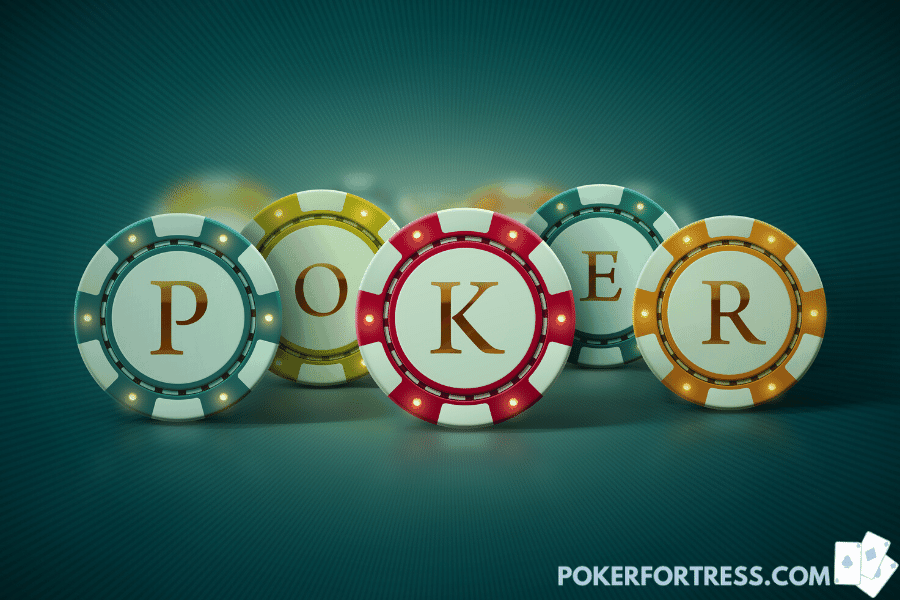
Plan, Plan, Plan!
There’s nothing worse than an unplanned poker game.
Not knowing what to play, how to play, and how many players will participate is the epitome of bad poker. This blunder makes it impossible to determine the number of chips that you need, and will only result in lousy game experience for everyone.
Having a plan in place is vital in making sure that you have enough poker chips to play comfortably. So before you start figuring out how many chips you need, it’s best to start asking the right questions that can help you plan the perfect poker game.
Another thing that you should plan out is the drinks and food. I have an in-depth article on perfect food and drinks for a poker night.
What game will you be playing?
Will you be playing a tournament, cash game, or Sit N’ Go? In a cash game, players can join and leave tables freely. So you should have enough chips in play even if players, who opt out of the table, decided to hold onto their chips.
Tournaments require even more chips because you host several players that exceed the capacity of any poker game. You only have two options when hosting a tournament; either you have enough chips for every player or be resourceful and use point-system to keep reusing the same chips in each round.

Sit N’ Go, on the other hand, only requires a certain number of chips in play. There are no options to rebuy, and you don’t have to worry about increasing the blinds. The number of chips on the table when the game starts will still be the same when the game ends.
How much will players be comfortable to bet?
Figuring out the minimum bet is vital to the players’ enthusiasm to participate and will directly affect their strategies. It’ll also help you determine the number of chips you need, together with the value for each color.
The lowest denomination that you can use for poker chips can never be lower than the minimum bet.
This general rule will directly affect the number you need for each chip color. If you’re playing with 2/4 blinds, having $1 chips may not be ideal, because the lowest amount that players can bet is $2.
What is the buy-in amount?
The general rule for setting the buy-in is to set it at least 40 to 100 times the big blind. So, if you’re playing with 2/4 blinds, your buy-in should be around $160 to $400. If you decide to have a $300 buy-in, multiply it by the number of participating players to get the value of chips that needs to be in play.
When setting the buy-in, you always need to consider having a balance between what’s comfortable for players and what can motivate them to stay in the game. In casual games, the buy-in is a consensus between every player, but it should always remain within the recommended range.
Will you use fixed or progressive blinds?
As the game progresses, the chips accumulate towards the top players. If you have a fixed blind, the progress of the game might be slower than what you intend.
Progressive betting is a rule that aims to increase the minimum bet over time.
When playing with progressive betting, instead of having 2/4 blinds throughout the game, bets will gradually increase. It should be twice the previous blinds, so in a 2/4 progressive betting, the blinds will increase to 4/8 after three levels, 8/16 after six levels, and 16/32 after nine levels.
Can players rebuy?
The option to rebuy will multiply the number of chips that you need. Instead of only covering the buy-in for each player, you’ll also need to factor in the rebuy that players make. You may want to use this as an opportunity to introduce higher value chips. These chips are vital in keeping the liquidity of chips in play.
Here’s a sample computation to determine the number of chips you need in games where rebuy is allowed:
(Players) x (Buy-In) = Rebuy Chips
(Players) x (Buy-In) + (Rebuy Chips) = Chips Available
How many players will be playing?
This question shouldn’t come as a surprise when figuring out the number of chips you need for the game. The number of players will always multiply the buy-in and rebuy. Knowing how many players will participate ensures that you have enough chips in play at any given time.
What will your stakes be?
Playing with cash will require more chips compared to poker games that use point-system.
When you use point-system for a poker game, players can trade chips for points, which can drastically reduce the number of chips you need.
Hosting a cash game, on the other hand, requires all chips to be in play. Since it acts as the game’s currency, players can’t trade their chips for cash, unless they opt out of the game. You need to maintain enough liquidity in chips to cover the amount that is in play.
Careful planning is the key to figuring out the number of chips that you need. Once you’ve answered these questions, the next step will be to figure out the values of chips that you will use for your game.
Chip Values and Denomination
If you’re still looking for poker chips to buy, there’s a good chance that you’ll only find unmarked chips. Being unmarked gives you the flexibility to define the value of each color and modify it based on the rules that you’ve set for the game.
Correctly valuing each color is crucial to ensuring the liquidity of chips. You also need to disclose the valuation to every player, even before the game starts. Failing to do so can ultimately ruin the value of chips that you’ve distributed, and may lead players to bet more than what they intend. Flexibility is the purpose of having unmarked chips, so never put the denomination on it.
There are six colors in a basic poker set; white, red, blue, green, black, and sometimes pink.
A full set of poker chips, on the other hand, has anywhere between 13 to 15 colors. Although there’s no official value assigned to each color, there’s a guideline that will help you define its values.
Defining Chip Values or Denominations
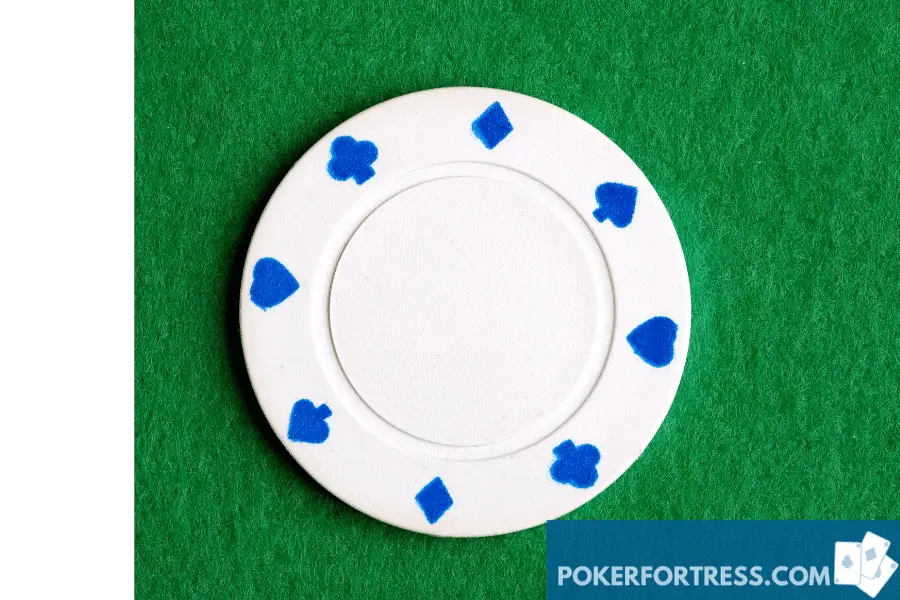
The easiest way to determine the value of each chip is to have the white chip valued at the minimum amount that any player can bet. Once you have the smallest denomination, appraising the subsequent colors will be effortless.
For example, if you’re playing with 1/2 blinds, the white chip should be $1; nothing more, nothing less. Having a $0.50 chip not only doubles the number of chips you need, but you’ll also be introducing chips that players may not even use. Using $2 as your lowest value will reduce the number of chips that you need but makes it impossible for players to bet the minimum.
If you value your chips too close or too far from each other, you’ll end up buying more chips than what you should. With a value of $1, $10, $50, and $100, a player needs to use seven white chips to make a $7 bet instead of just three; one $5 chip and two $1 chips.
Again, there’s no official rule in valuing poker chips, but the tables below will help you define the values for each color.
Basic Poker Chip Colors and Standard Values
| Chip Color | Standard Value | Chip Color | Standard Value |
| White | Small Blind | Blue | Red x 2 |
| Pink | Big Blind | Green | Blue x 2 |
| Red | Small Blind x 5 | Black | Green x 5 |
Basic Poker Chip Values in 1|2 Poker Game
| Chip Color | Standard Value | Chip Color | Standard Value |
| White | $1 | Blue | $10 |
| Pink | $2 | Green | $20 |
| Red | $5 | Black | $100 |
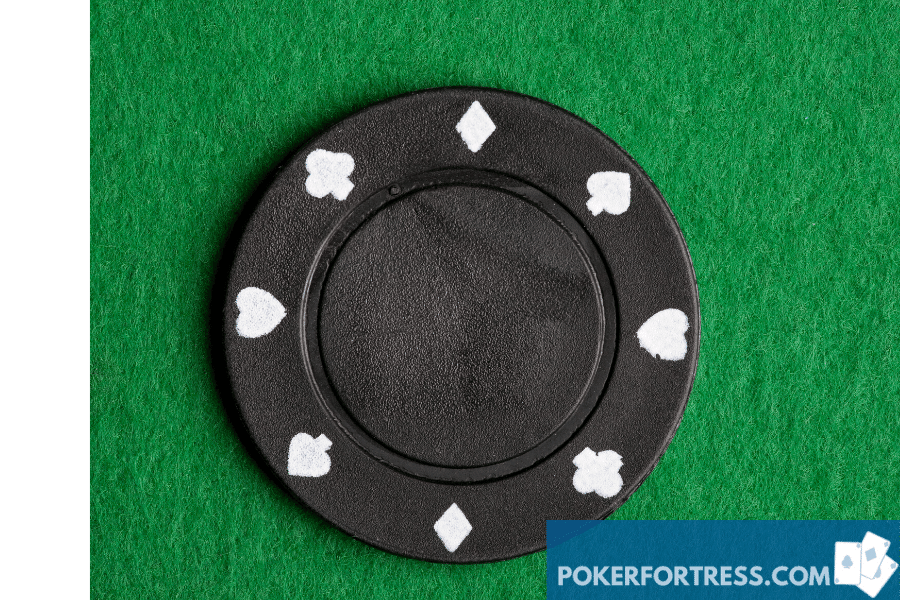
Using this table, you’ll have enough room for each color, covering as many denominations as possible without going too close or too far from each other.
It’s important to note that in a cash game, the black can never have a value of more than half the buy-in. This limitation ensures that all chips are in play while maintaining liquidity in all colors.
Full Poker Chip Colors and Standard Values
| Chip Color | Standard Value | Chip Color | Standard Value |
| White | Small Blind | Black | Orange x 2 |
| Yellow | Big Blind | Pink | Black x 2.5 |
| Red | Yellow x 5 | Purple | Pink x 2 |
| Blue | Red x 2 | Burgundy | Purple x 2 |
| Grey | Blue x 2 | Light Blue | Burgundy x 2 |
| Green | Red x 5 | Brown | Light Blue x 2.5 |
| Orange | Green x 2 |
Full Poker Chip Values in 1|2 Poker Game
| Chip Color | Standard Value | Chip Color | Standard Value |
| White | $1 | Black | $100 |
| Yellow | $2 | Pink | $250 |
| Red | $5 | Purple | $500 |
| Blue | $10 | Burgundy | $1000 |
| Grey | $20 | Light Blue | $2000 |
| Green | $25 | Brown | $5000 |
| Orange | $50 |
Using a full set of poker chips would only make sense in a tournament with progressive betting. In a game with 1/2 blinds, you can only introduce pink chips at the 3rd, purple at the 5th, burgundy at the 7th round, and so on. This process is called “coloring up,” which aims to remove all low-value chips in play gradually.
These values don’t necessarily have to be the same in every poker game. You can round the values up or down, depending on the bets that are in play. But remember, you can only take advantage of this flexibility in defining values if the chips remain unmarked.
How Many of Each Denomination?
Now that you have the value for each color, the next step is to figure out how many of each color you should distribute.
The standard guide in chip distribution is the “4-3-2-1 rule”.
This rule suggests that 40% of all chips should be the lowest, 30% for the next higher chip, 20% for the second-highest, and 10% for the highest-value chip.
Modifying the rule
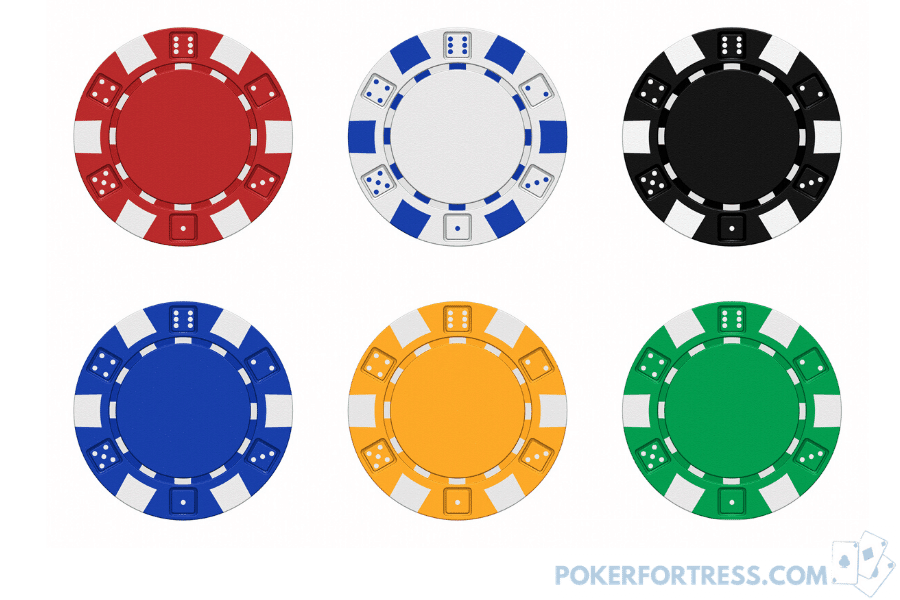
Keep in mind that the distribution of chips should be coherent with your minimum bets and buy-in. So if 4-3-2-1 resulted in a higher buy-in, you could modify it to suit your game rules. You can try 4-2-2-1-1 to introduce more colors in play or 5-3-1-1 to increase the number of chips in play.
When distributing chips, flexibility is crucial. The pink for the basic and yellow for the full set may seem unnecessary, but it will give you enough room to distribute the chips evenly.
Additional tips when distributing chips
Knowing the basics of chip distribution is not enough. You still need to familiarize yourself with the thought processes that determine the number of chips required in each game. Here are some suggested rules for buying and distributing chips to your players:
- A safe number when distributing chips is 40 to 60 chips per player. The total value of these chips should be coherent with your buy-in. Too high or too low can directly affect the gameplay of each player.
- Chips play a vital role in the strategic betting of each player, so it should neither force players to hold onto high-value chips nor have too many low-value chips that encourage them to place their bets blindly.
- Having an even chip distribution will give players enough versatility, allowing them to be more strategic. Too many high-value chips may force players to fold more often, even when they have a good hand.
- If you allow rebuys, then you need to take this into account when figuring out the number of chips that you need. Rebuys is where you can introduce higher-value chips into the game, and will save you from the cost of additional low-value chips.
- Not every player will rebuy, but others will rebuy more than once. Unless you have a rebuy limit in place, a safe number for reserve chips is equal to the total amount in play.
- Having four to five colors in play will give you a balance of liquidity in chips and fewer chips needed for the game. You also need to have one or two high-value colors for rebuys, if you want to keep a balance in your chips.
- You can use “coloring up” to save yourself from the cost of additional chips. You can color up chips in two ways; first is to keep increasing the value of white to match the minimum bet, and the second is to remove all low-value chips and replace them with higher-value chips.
Chip Distribution Based on Game Format
The game format and number of players are two of the biggest factors that can affect the number of chips you need in a poker game. Whether you are playing Sit N’ Go, cash game or tournament, having adequate chips is crucial to a smooth sailing game.
There’s nothing worse than starting a poker game and running out of chips in the middle. It will affect the strategies of other players, while others can take advantage of the lack of chips. Ultimately, running out of chips can alter the course of any poker game. So instead of being reactive, let’s just prevent it by figuring out how many chips you need for different game formats.
How Many Poker Chips Do You Need For a Poker Sit N’ Go?
Sit N’ Go or SNG is the easiest to setup.
You don’t have to factor in rebuys or increasing blinds. You only need to have enough chips to distribute to each player, and introducing high-value chips won’t be necessary. Think of it as a knockout contest, where a player who loses all of his chips is out of the game until only one player remains.
In a casual Sit N’ Go, you’ll need at least 30-40 chips for each player — that’s it! If you have a 300-chip budget poker set, you can accommodate up to seven players, and possibly even eight, if you’ve carefully defined and distributed the chips.
Just remember the following guidelines when defining the values of your chips for Sit N’ Go:
- White chips should always be the same amount as your small blind.
- Red chips should be five times the amount of your small blind.
- Blue and green chips are twice the value of the previous color.
- Black chips should be at least half your buy-in amount, but only when you need more chips.
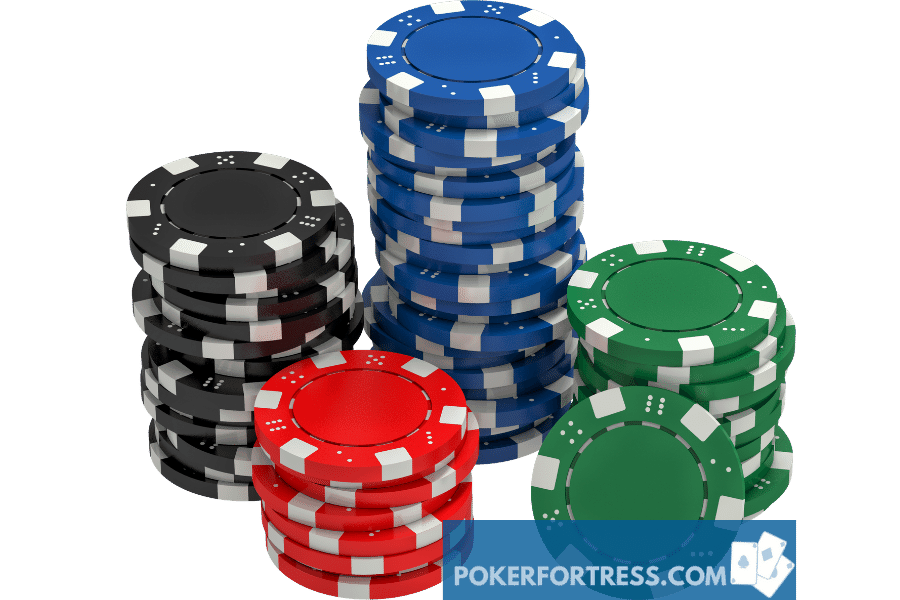
Using these guidelines, let’s distribute chips based on a 1/2 ($200) SNG with six players on the table:
- Buy-in should be 40 to 100 times the big blind. So for this example, it’ll be $200.
- Each player will receive the following; 15 white, 9 red, 6 blue, and 4 green chips.
- After distribution, each player should have 34 chips with a total value of $200.
Note: We didn’t use the black chips because the low-value chips were sufficient to cover the buy-in for all the players.
How Many Poker Chips Do You Need For a Poker Cash Game?
Similar to Sit N’ Go, a poker cash game doesn’t have a prize pool. The chips act as the player’s currency, and if a player runs out of chips, he’s out of the game unless he rebuys. Although cash games require more chips than SNG, it’s still easier to set up compared to tournaments. There are no blinds to increase, and you can introduce higher-value chips through rebuys.
In a poker cash game, you’ll need at least 40-50 chips for each player, and higher-value chips for rebuys. If you’re going to play with 2-5 players, a 300-chip budget poker set will let you play comfortably without running out of chips. It includes five basic colors; 100 pieces of white chips and 50 pieces of the other four colors; red, blue, green, and black.
A usual 500-chip poker set includes 150 white, 200 red, 100 green, and 50 black chips. It can accommodate 5 to 8 cash game players comfortably, including potential rebuys.
You only need to make sure that the value of your chips is coherent with your blinds and buy-in. For example, valuing your white chip at $1 for a 1/2 cash game is perfectly fine, but the same value for a 2/4 game may require more chips than what is necessary.
Know what the optimal number of players behind a poker table is? Why do casinos use a specific number of players and don’t deviate from them? Then read this article about an optimal number of poker players.
How Many Poker Chips Do You Need For A Poker Tournament?
Casual poker tournaments require more chips in play, but you can color up the chips to ensure that you have enough liquidity in chips. Coloring up will also help you speed up the tournament because it forces the players to bet higher amounts.
Tournaments usually have more than ten players, but you can be creative in setting up tournaments to save chips. For example, players may exchange chips with points, and have the next group use the same chips.
There are no buy-ins and rebuys to factor in, but you need to introduce high-value chips early into the game. By doing this, you’ll be able to distribute all the chips evenly, and you’ll have enough for everyone who is participating in the tournament. Each player should have at least 40-60 chips.
The best way to host a poker freezeout (standard) tournament is to have a 500-chip poker set for every 9 participants.
Tournaments last for hours, and you need to keep increasing the blinds to speed it up. Your chips need to keep up with the value as you increase the blinds, which makes coloring up important for tournaments. By coloring up your chips, you’ll need less as the tournament progresses, because the value of each chip increases.
Chip Distribution Based on Player Count
Aside from the general rule of preparing at least 40 to 60 chips per player, you also need to consider chip distribution. By carefully defining the value of each chip, you’ll be able to accommodate more players with fewer chips.
How Many Poker Chips Do You Need For 2 Players?
If you’re planning to play poker with another friend, a 100-chip should suffice. A budget poker set usually includes four chip colors with 25 pieces each. You only need to define the values of each chip for it to be coherent with the buy-in.
For example, in a 1/2 SNG with a buy-in of $200, you’ll only need ten white, ten red, eight blue, and three green chips for each player. With proper distribution, 100 chips can even accommodate three players.
How Many Poker Chips Do You Need For 6 Players?
Six is the ideal number of players in any poker game. If you’re planning to invest in a poker set, a 300-chip set is the most practical. It lets you have enough chips for an ideal poker game without breaking the bank.
An average 300-chip poker set includes 100 pieces of white, and 50 pieces of the other four colors. It can accommodate up to 8 Sit N’ Go players and up to 6 players for cash games with enough to cover rebuys.
How Many Poker Chips Do You Need For 10 Players?
If you are playing with ten players, it would be better to devise a tournament instead. Although possible with a 500-chip set, having ten people playing at the same time may not be ideal.
A usual 500-chip basic poker set includes 200 red, 150 white, 100 green, and 50 pieces of black chips. Although it can accommodate up to ten participants in a tournament, you need to be careful in defining the values and distributing each chip.
Make Sure You Have All The Essentials
Cheap doesn’t always mean great value, and the same is true with poker accessories.
If you want to recreate the feel of professional poker, you’ll need to invest in a few accessories that can improve your game.
Sure, any table will do when playing a casual poker game. But when cash is involved, wouldn’t it be nice to play a game of luck in a sturdy and aesthetically appealing poker table?
The chip is the most important poker accessory. Before you buy one, make sure that they are high-quality unmarked composite chips. Sure, it can be tempting to spend money on cheap plastics, but they are flimsy and aren’t fun to play with at all.
You’ll also need blinds, buttons, and a deck of cards to play poker, but some poker sets include all of these accessories. You just have to pick the one that has all the necessities of a poker game.
Conclusion
Chips are at the core of any poker game. You can recreate a poker table and use any standard 52-card deck, but poker can never be poker without the chips! They carry a bit of a price tag, but there’s just no substitute for it.
That’s why it’s crucial to figure out how many chips you’ll need for a poker game. By doing so, you’ll avoid spending on chips that you won’t need for your game without affecting the gameplay and your flexibility in distributing the chips.



